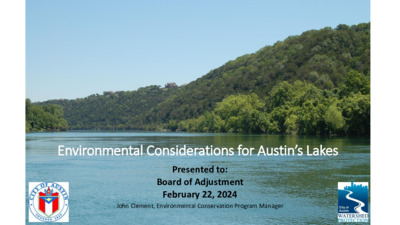ITEM03 LA ENVIRONMENTAL — original pdf
Backup

Environmental Considerations for Austin’s Lakes Presented to: Board of Adjustment February 22, 2024 John Clement, Environmental Conservation Program Manager LAKE AUSTIN - Finding the Balance • Drinking Water • Residential • Commercial • Boating/Marina • Parkland • Fishing • Passive Recreation Environmental Issues Zebra Mussels Bank Erosion Shoreline Erosion Poor Shoreline Habitat Non-Complying Structures Compliance/Work Without Permits Wave Impacts Riparian Zone Functions A robust shoreline vegetative community improves water quality, prevents erosion, and aids in flood control. Trees & deep-rooted plants prevent erosion. Dense shoreline development degrades shoreline health. Poor Riparian Function VS Good Riparian Function Poor Functioning Good Functioning Costs of Degraded Water Quality ▪ Water treatment costs due to suspended sediment ▪ Algae proliferations ▪ Poor fishery ▪ Lowered Austin Lake Index scores in ▪ Habitat ▪ Invertebrates ▪ Vegetation Environmental Review • Site plan & Subdivision compliance with LDC 25-8 Subchapter A • Boat docks/shoreline modifications/shoreline access require site plans • DSD environmental review staff • CWQZ compliance • Erosion controls • Restoration • Cut/Fill • WPD environmental review staff • CEF setbacks • Bulkheads • Dredging • Land capture/fill in the lake • Floodplain modifications & restoration (riparian functioning) § 25-8-261 Critical Water Quality Zone Trams Stairs CWQZ on all Lakes: - 75’ from shoreline (492.8 msl) for single family - 100’ for all other uses (1) A dock, bulkhead or marina, and necessary access and appurtenances, are permitted in a critical water quality zone subject to compliance with Chapter 25-2, Subchapter C, Article 12 (Docks, Bulkheads, and Shoreline Access) Gangways § 25-8-281(C) Critical Environmental Features Canyon Rimrock and 150’ CEF Buffer Canyon Rimrock Wetland Seep Spring 25-8-652 – Restrictions on Development Impacting Lakes Unpermitted fill in Lake (A) The requirements of this section apply to development on or adjacent to Lake Austin, Lady Bird Lake, or Lake Walter E. Long. (B) Except as otherwise provided by this section, placing fill or dredging in a lake is prohibited. (C) A retaining wall, bulkhead, or other erosion protection device may not capture or recapture land from a lake unless doing so is required to restore the shoreline to whichever of the following boundaries would encroach the least into the lake: (1) the shoreline as it existed 10 years prior to the date of application, with documentation as prescribed by the Environmental Criteria Manual; or (2) the lakeside boundary of the subdivided lot line. (D) A bulkhead may be replaced in front of an existing bulkhead once, if: (1) the existing bulkhead was legally constructed; and (2) construction of the replacement bulkhead does not change the location of the shoreline by more than 6 inches; and (3) the director of the Watershed Protection Department determines that there is no reasonable alternative to replacement of the bulkhead in the location of the existing bulkhead. (E) The director may approve less than 25 cubic yards of dredging in a lake if the dredging is necessary for navigation safety. Land Use Commission Variances 25-8 Land Use Commission Variance Findings (paraphrase of 25-8-41) Board of Adjustment Variance Findings (paraphrase of 25-2-474) • Requirement will deprive the applicant of a privilege given to owners of other similarly situated properties with approx. contemporaneous development; • Variance is not necessitated by scale, layout, construction method, or other design decision made by the applicant, unless the design provides greater environmental protection; • Minimum deviation necessary to allow a reasonable use of the property; • No significant probability of harmful environmental consequences; • No harm to water quality. • Additional findings for Critical Water Quality Zone variances: • Requirement prevents a reasonable, economic use of the entire property; • Minimum deviation necessary to allow a reasonable, economic use of the entire property. • Requirement does not allow for a reasonable use; • Hardship is unique/not characteristic of the area; • Development does not • Alter character of area, • Impair use of adjacent property, • Impair the purpose of the regulation; Situations Involving Both EV Commission and BoA Tram in Setback or Slopes /Rimrocks Dock Extension/Dredging Construction in a CEF buffer Versus Mechanized access on slopes greater than 35% or in LA shoreline setback • EV Commission reviews impact of construction on CEF • BoA can review for broader impacts to the LA zoning district Dredging greater than 25 cy Versus Extending the dock greater than 30’ • EV Commission reviews impact of dredging on water quality • BoA reviews hardship, reasonable use, and area character of dock extension (navigation safety) Questions?